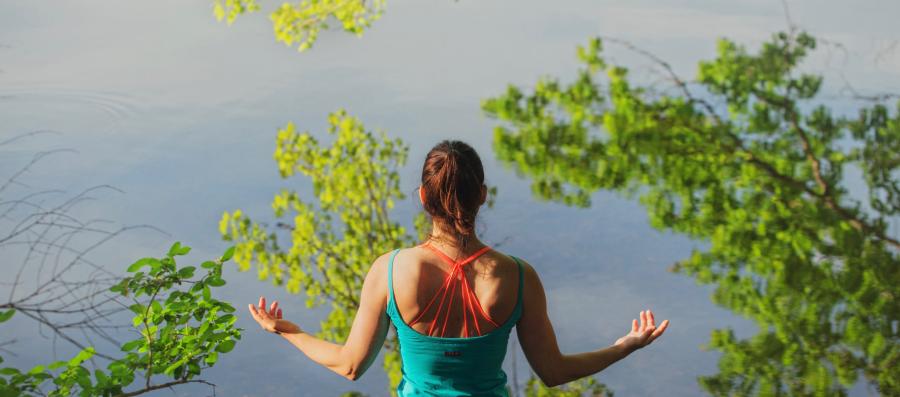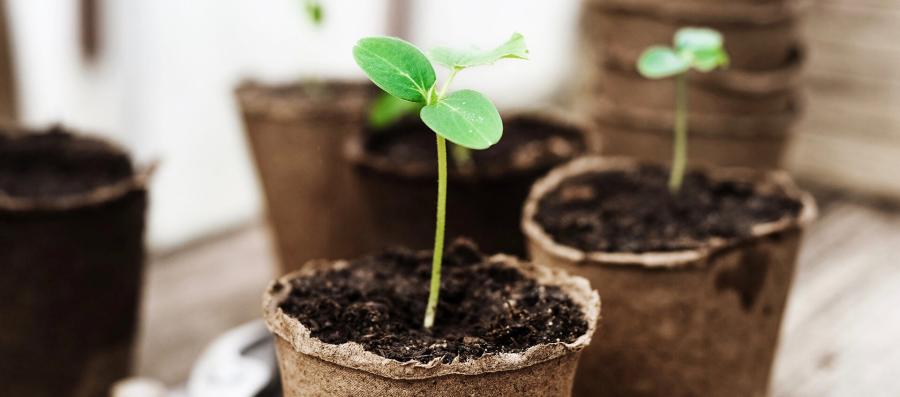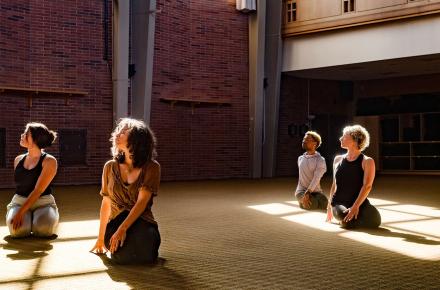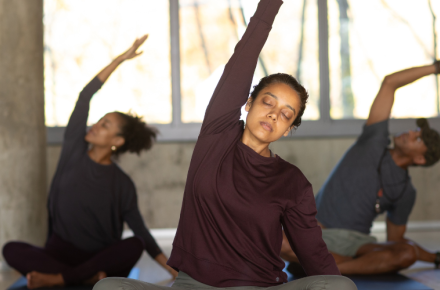How Meditating with Nature Can Ground and Connect Us


April 6, 2020
Friends, in times like this, we need grounding. With all of the unknowns swirling through the collective consciousness, the mind can get swept away. It can be hard to feel settled, to feel safe, to feel like you can anticipate what the next hour or day will bring.
In these times, if you have a regular practice, it may not work the way it usually does. I know that my mind has been swirling, and I’ve been checking my phone way too much. But what helps me is meditating with nature: watching the wind blowing through the evergreens, noticing the little birds going about their day, spying squirrels hunting for food and bounding here and there. These little moments of mindfulness in nature help me feel more grounded, connected, and reassured. The cycles of nature—her ups and downs, her constant change within familiar timetables—offer some reassurance and a sense of perspective.
This too shall pass, for every rainstorm, every long winter, every day full of unknowns eventually comes to an end. Nature gently reminds us of these universal truths. She shows us how things work, and if we listen and draw close, she shows us how to follow her example.
Meditation Without Walls
Many people think that if they cannot empty their mind of thoughts while sitting on a cushion inside a temperature-controlled building, they are “bad at meditating.” The truth is, these same people, if they found time to sit, or walk, or swim outside, or gaze into a campfire, or climb a tree, might find themselves quite adept at allowing their attention to settle into the awe and wonder of each moment. The practice of meditation—of allowing your awareness to be absorbed in what is arising in the present moment—most certainly grew out of people’s experiences of being in close contact with nature: in a forest, beneath a tree, beside a river or ocean, in a desert, atop a mountain, or walking with their palms touching the soft tops of prairie grass while breathing in the light of the setting sun.
Most modern yoga and meditation spaces are indoors and are designed to eliminate “distractions”—sights, sounds, and strong sensations in the environment are blocked, so that our attention can move inward and we can probe the depths of our own consciousness through breathing, movement, and self-observation. This practice cultivates “the witness,” our ability to be with life as it is, and we learn to ride the waves, rather than reacting out of fear or habit. But this way of practicing can also reinforce a sense of separateness from the rest of life, and a preoccupation with one’s inner world, in isolation from nature, from which we can derive so much nourishment, meaning, and healing.
Yoga and meditation have profoundly enhanced my time outdoors—and vice versa. In fact, it was the experiences I had on the grounds around Kripalu as a residential volunteer many years ago that were the seed for our School of Mindful Outdoor Leadership, in which we train guides to harness the power of mindfulness to connect modern people with the land they live on.
Evolving in Harmony with Nature
A relaxed, meditative state arises effortlessly when we are in contact with the land because our bodies—our senses and our nervous systems, the biological technology through which we experience the wonder and mystery of life—evolved in relationship to the earth and our local environments. Ears evolved in relationship to wind, birdsong, and flowing water. Sight evolved in relationship to the moon and sun, and the infinite ways that light reflects and bounces off leaves, ice, and water. Our sense of touch developed in relationship to moss, cool stones, rough bark, soft animal fur, water, and skin. Yoga, meditation, and most of the world’s contemplative and mystical traditions evolved outside, in wild places. This seems evident when we look at the names for the yoga postures, first referenced in the 1400s in the Hatha Yoga Pradipika: Cow’s Face, Tortoise, Cockerel, Peacock, Cobra and Lotus, and, of course, Mountain and Tree.
Read Part 1 of this series:
The Buddha attained enlightenment beneath the Bodhi Tree (the Tree of Awakening) and here is his instruction to his students in the Satipatthana Sutta:
“Herein a monk, having gone to the forest, to the foot of a tree or to an empty place, sits down, with his legs crossed, keeps his body erect and his mindfulness alert. Ever mindful he breathes in, and mindful he breathes out. Breathing in a long breath, he knows, ‘I am breathing in a long breath’; breathing out a long breath, he knows, ‘I am breathing out a long breath’; breathing in a short breath, he knows, ‘I am breathing in a short breath’; breathing out a short breath he knows, ‘I am breathing out a short breath.’”
Nature is a place of connection, where we are more easily able to see the ways that life exists in a state of what Thich Nhat Hanh calls “interbeing.” Or, as the naturalist and conservationist John Muir once said, “The surest way into the universe is through a forest wilderness.”
Indoor practices can be incredibly powerful, and at different times of life, this kind of retreat into an internal, human-made space may be exactly what is called for. But this is not the only way to practice. Because there are other times in life when we crave a deeper relationship with the great web of living things, when we long to hear the call of the loon, or gaze spellbound at a mountain, blown by a strong wind. Times when our soul hungers for the company of wild things, and the sighing of the wind and the churning of the ocean are the only meditation teachers we need.






















































